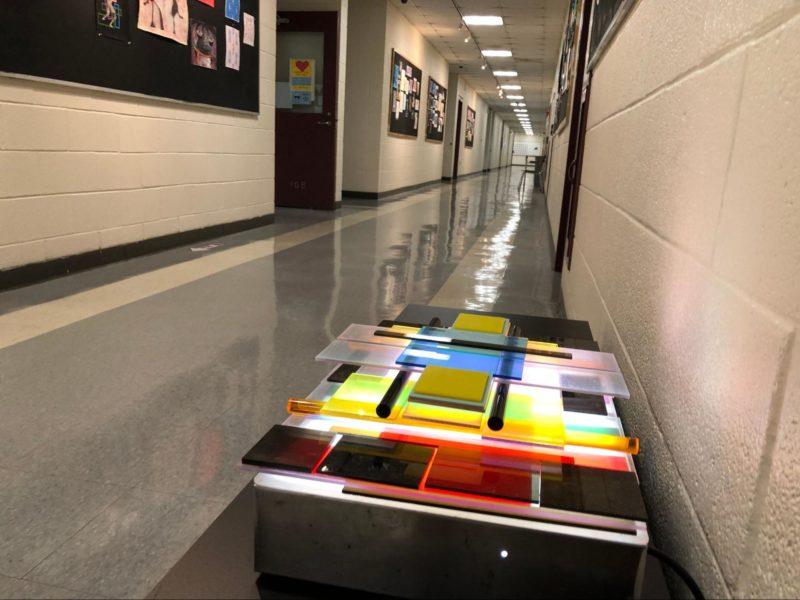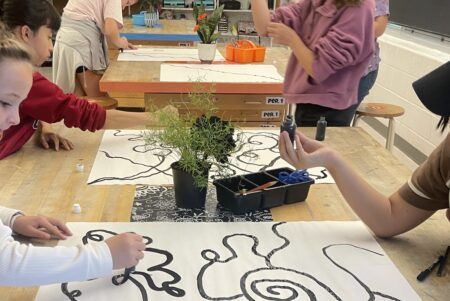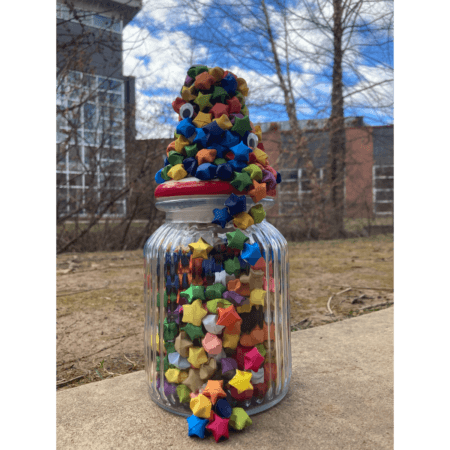Teaching with Contemporary Art
Teaching Beyond the Pandemic

Student artwork. Photo by Joe Fusaro.
What have we learned, as a result of the COVID-19 pandemic? How will our practices as educators change?
For more than fourteen months, educators across the country and around the world have wrestled with the best ways to teach students virtually or teach a blend of students, in the classroom and online, at the same time. Back in March 2020, most teachers were not given more than a few days to prepare, and to say it’s been smooth sailing would be a gross exaggeration.
But once we’re out from under the shadow of this pandemic, I hope teachers from all disciplines, not just the visual arts, will reflect on lessons learned from working with students virtually. With this in mind, I’d like to talk about three lessons I have embraced in my own teaching.
Lesson One: The doorbell that chimes every time a student signs into my Zoom session has become a reminder and an evolving lesson. Just as I would greet someone who rings the doorbell to my home, I have learned to acknowledge each person as they come into the Zoom room. Prior to the pandemic, students would file into my classroom, sit down, and, after taking attendance, I would simply begin the lesson. Never did I take the opportunity to say each student’s name aloud when they entered the classroom. Repeating students’ names on a regular basis in some ways enabled me to become more comfortable using their names in conversation: “Good morning, Justin,” led to, “Justin, what do you think?” and “Justin, can you expand on what Fiona just said?” It’s a small act that goes a long way. More than a year into teaching during this pandemic, I can say with confidence that I have a different sense of comfort and familiarity with my students than I may have had during other years. Because we finished the school year teaching within a hybrid model, and may continue to do so for some time, students who are physically inside the classroom with me have become more familiar with the workings of our studio. They engage each other as sounding boards for works in progress, much like the way that Olafur Eliasson emphasizes teamwork in his studio in order to realize ideas and synthesize many different disciplines and talents.

Student artwork. Photo by Joe Fusaro.
Lesson Two: Teaching during a pandemic has also forced many of us to more often utilize online tools to assess progress and help set goals with our students. Never before this past year had I used Google Slides and other digital discussion tools as often, to give students the agency to demonstrate what they’re learning over time. Prior to the pandemic, I was typically racing around the classroom, checking on student progress during the course of a unit or lesson. Now, students have become accustomed to a rhythm of sharing the beginning, middle, and late stages of their assignments using online tools that allow me, as well as their classmates, to give feedback, offer praise, and ask questions. This is important because we can all share in the process and progress that is happening across our class. Everyone can see each other’s work evolve.
Lesson Three: Prior to the pandemic, our school district was very involved with addressing issues of diversity, equity, and inclusion. For the past few years, staff members across the district have been regularly attending “Undoing Racism” trainings (created by the People’s Institute for Survival and Beyond) and we continue to participate in ongoing conversations about how to be aware of our privilege, how to work more effectively with our students of color, and how to curate our classrooms with an eye toward sharing examples of artists that more closely mirror the breadth of our student population. When I think about the past year, I realize that I am much more selective about the artists and artworks I use to help me teach. While it might be easier to share a range of artists who are all white, and often male, digging deeper into not just what is possible but also who is possible in the curriculum has improved my teaching. For example, this year’s introductory Studio Art classes (composed of mostly ninth-grade students) were introduced to artists such as Louise Despont, Nicholas Hlobo, Robin Rhode, Zanele Muholi, Kerry James Marshall, Catherine Opie, Janine Antoni, and Postcommodity.
I recently asked my students about the things they have learned as a result of the pandemic, particularly within our own class, and they shared many feelings. Two student quotes, echoed by others in the class, stood out:
“Seeing so many examples by different artists gives us ideas to make work that is important to us. I feel inspired by artists who think like I do.”
“We can make work that really says something, instead of just making a project for a grade.”
As we close out this year and get ready for 2021–2022, I look forward to developing even better relationships with students, continuing to find more effective ways to highlight and assess progress, and using our work for diversity, equity, and inclusion to better reach more of my students.



